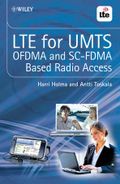The air interface is the scarcest resource of a mobile network and the industry is therefore not only looking to improve peak data rates but also to improve efficiency under everyday conditions. Voice calls are and probably will remain for quite some time to come the most popular mobile service so reducing the overall amount of spectrum required for it to have more room for bandwidth intensive applications is an appealing goal.
Holma and Toskala's book on LTE I reviewed recently has an interesting analysis of this topic. The results sound quite amazing to me so I thought I'd share them with you. In their chapter on VoIP they compare the air interface efficiency of GSM, UMTS, HSPA and LTE and here are some of the highlights:
Voice over GSM, UMTS and HSPA is circuit switched in nature in their study. Therefore they have the advantage that there is little overhead incurred by the different layers of the IP protocol stack. GSM voice capacity was calculated for the Enhanced Full Rate (EFR) and Adaptive Multi Rate (AMR) codecs mostly used in today's GSM network. It's not straight forward to calculate how many voice calls fit into 1 MHz, as adjacent GSM base stations have to use different channels to avoid interference. Due to the modulation, directly adjacent channels can't be used and interference is countered by using hopping carriers, i.e. the transmission frequency is changed for each frame. Taking all these and other things into account they come to the conclusion that there can be around 4 EFR calls per MHz or 8 AMR calls. Quite a difference already.
The same calculation for UMTS and HSPA is probably a bit simpler as all base stations use the same frequency. Interference from neighboring base stations are part of the design and limit the available bandwidth in neighboring cells. The more load in a cell, the more interference in neighboring cells and the less capacity there. With a simulation of a real life scenario Homa and Toskala estimate the voice capacity per MHz of UMTS of around 12 calls and of HSPA of around 24 (both AMR 12.2). Note that voice over HSPA is not yet deployed in life networks as it's a relatively new feature. For details have a look here.
And now over to LTE. Like for the other technologies, the authors have taken lots of layer 1, 2 and 3 mechanisms into account like for example what's the efficiency of using a 1 ms TTI for a single 20 ms voice frame, how buffering several voice packets and then sending them together impacts performance and latency, different voice codecs, dynamic vs. persistent scheduling, use of signaling resources, etc. etc. The surprising result, at least to me, is that voice capacity is even higher as for HSPA and they estimate it to be 50 parallel calls per MHz for AMR 12.2 and over 80 parallel calls per MHz with AMR 5.9.
Summary
The numbers are stunning and offer interesting opportunities in the future. According to these numbers LTE is 10 times more efficient to transport voice calls than the current GSM deployment. That is, of course, if the voice calls are controlled by the operator and all optimizations used for the calculation are put into the game. For over-the-top VoIP, that's hardly going to be the case.

